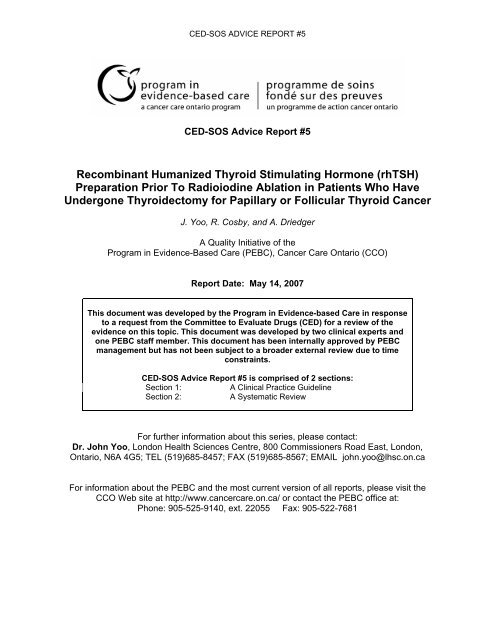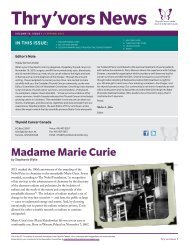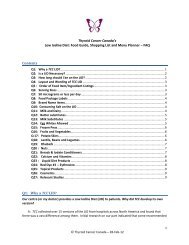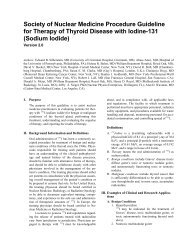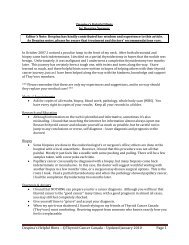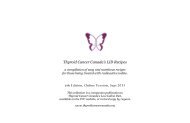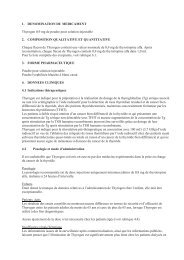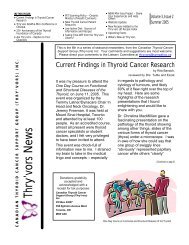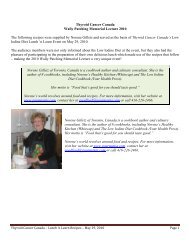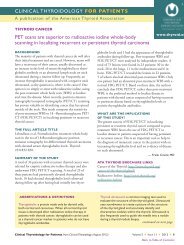Recombinant Humanized Thyroid Stimulating Hormone (rhTSH ...
Recombinant Humanized Thyroid Stimulating Hormone (rhTSH ...
Recombinant Humanized Thyroid Stimulating Hormone (rhTSH ...
Create successful ePaper yourself
Turn your PDF publications into a flip-book with our unique Google optimized e-Paper software.
CED-SOS ADVICE REPORT #5CED-SOS Advice Report #5<strong>Recombinant</strong> <strong>Humanized</strong> <strong>Thyroid</strong> <strong>Stimulating</strong> <strong>Hormone</strong> (<strong>rhTSH</strong>)Preparation Prior To Radioiodine Ablation in Patients Who HaveUndergone <strong>Thyroid</strong>ectomy for Papillary or Follicular <strong>Thyroid</strong> CancerJ. Yoo, R. Cosby, and A. DriedgerA Quality Initiative of theProgram in Evidence-Based Care (PEBC), Cancer Care Ontario (CCO)Report Date: May 14, 2007This document was developed by the Program in Evidence-based Care in responseto a request from the Committee to Evaluate Drugs (CED) for a review of theevidence on this topic. This document was developed by two clinical experts andone PEBC staff member. This document has been internally approved by PEBCmanagement but has not been subject to a broader external review due to timeconstraints.CED-SOS Advice Report #5 is comprised of 2 sections:Section 1:A Clinical Practice GuidelineSection 2:A Systematic ReviewFor further information about this series, please contact:Dr. John Yoo, London Health Sciences Centre, 800 Commissioners Road East, London,Ontario, N6A 4G5; TEL (519)685-8457; FAX (519)685-8567; EMAIL john.yoo@lhsc.on.caFor information about the PEBC and the most current version of all reports, please visit theCCO Web site at http://www.cancercare.on.ca/ or contact the PEBC office at:Phone: 905-525-9140, ext. 22055 Fax: 905-522-7681
CED-SOS ADVICE REPORT #5CED-SOS Advice Report #5: Section 1<strong>Recombinant</strong> <strong>Humanized</strong> <strong>Thyroid</strong> <strong>Stimulating</strong> <strong>Hormone</strong> (<strong>rhTSH</strong>)Preparation Prior To Radioiodine Ablation in Patients Who HaveUndergone <strong>Thyroid</strong>ectomy for Papillary Or Follicular <strong>Thyroid</strong> Cancer:A Clinical Practice GuidelineJ. Yoo, R. Cosby, and A. DriedgerA Quality Initiative of theProgram in Evidence-Based Care (PEBC), Cancer Care Ontario (CCO)Report Date: May 14, 2007QuestionWhat is the role of recombinant humanized thyroid stimulating hormone (<strong>rhTSH</strong>)preparation prior to radioiodine ablation (RA) in patients who have had thyroidectomy forpapillary or follicular thyroid cancer? The outcomes of interest are serum TSH levels, results ofpost-therapy scans, iodine biokinetics in thyroid remnants, serum thyroglobulin, urinary iodineexcretion, and quality of life (QOL).Target PopulationThe target population is comprised of adult non-pregnant patients with papillary orfollicular thyroid carcinoma who have undergone total, near-total, or sub-total thyroidectomy withgross complete resection of the disease and no known distant metastases.RecommendationsThere is a paucity of randomized controlled trial (RCT) evidence related to the clinicalquestion, owing to the fact that thyroid cancer is a rare event. Based on the interpretation ofevidence from randomized controlled trials, cohort studies, and retrospective studies, thefollowing recommendations are made:• <strong>Thyroid</strong> remnant ablation with radioiodine can be performed either followingadministration of <strong>rhTSH</strong> or following thyroid hormone withdrawal.• In selected patients who cannot tolerate prolonged hypothyroidism or in patients whocannot achieve satisfactory elevation of endogenous TSH by means of thyroid hormonewithdrawal, <strong>rhTSH</strong> may be the only option for radioablation.• <strong>rhTSH</strong> has significantly improved measures of quality of life compared to thyroidhormone withdrawal.PRACTICE GUIDELINE – page 1
CED-SOS ADVICE REPORT #5Key Evidence• One RCT, two cohort studies, and one retrospective study were located and reviewed.• In three of the four studies, successful ablation rates (defined as a negative post-radioiodineablation follow-up whole body scan [WBS]) were not significantly different in the <strong>rhTSH</strong> andthe hypothyroid (HYPO) preparation states.• The fourth study reports a significantly lower successful ablation rate in the <strong>rhTSH</strong> rate whensuccess is defined as a negative WBS. However, if success is defined as a negative scanor undetectable serum thyroglobulin (Tg) level even with positive uptake in the thyroid bed,then the difference between these methods of RA is no longer significantly different.• In all four studies, serum Tg at post-RA follow-up did not differ significantly betweenmethods of RA preparation.• Only one of the four studies assessing <strong>rhTSH</strong> preparation prior to RA reported QOL data.Consequently, QOL information was supplemented with results from three other studiesassessing the use of <strong>rhTSH</strong> preparation for diagnostic monitoring purposes.• All the studies assessing QOL demonstrated that QOL was decreased or significantlydecreased when withdrawal of hormone therapy was the method of preparation used foreither RA or diagnostic follow-up.FundingThe PEBC is supported by Cancer Care Ontario (CCO) and the Ontario Ministry of Health and Long-TermCare. All work produced by the PEBC is editorially independent from its funding agencies.CopyrightThis evidence-based series is copyrighted by Cancer Care Ontario; the series and the illustrations hereinmay not be reproduced without the express written permission of Cancer Care Ontario. Cancer CareOntario reserves the right at any time, and at its sole discretion, to change or revoke this authorization.DisclaimerCare has been taken in the preparation of the information contained in this document. Nonetheless, anyperson seeking to apply or consult the evidence-based series is expected to use independent medicaljudgment in the context of individual clinical circumstances or seek out the supervision of a qualifiedclinician. Cancer Care Ontario makes no representation or guarantees of any kind whatsoever regardingtheir content or use or application and disclaims any responsibility for their application or use in any way.Contact InformationFor further information about this series, please contact Dr. John Yoo, London Health Sciences Centre,800 Commissioners Road East, London, Ontario, N6A 4G5; TEL (519)685-8457; FAX (519)685-8567;EMAIL john.yoo@lhsc.on.caFor information about the PEBC and the most current version of all reports,please visit the CCO Web site at http://www.cancercare.on.ca/ or contact the PEBC office at:Phone: 905-525-9140, ext. 22055 Fax: 905-522-7681PRACTICE GUIDELINE – page 2
CED-SOS ADVICE REPORT #5CED-SOS Advice Report #5: Section 2<strong>Recombinant</strong> <strong>Humanized</strong> <strong>Thyroid</strong> <strong>Stimulating</strong> <strong>Hormone</strong> (<strong>rhTSH</strong>)Preparation Prior To Radioiodine Ablation in Patients Who HaveUndergone <strong>Thyroid</strong>ectomy for Papillary Or Follicular <strong>Thyroid</strong> Cancer:A Systematic ReviewJ. Yoo, R. Cosby, and A. DriedgerA Quality Initiative of theProgram in Evidence-Based Care (PEBC), Cancer Care Ontario (CCO)Report Date: May 14, 2007QUESTIONWhat is the role of recombinant humanized thyroid stimulating hormone (<strong>rhTSH</strong>)preparation prior to radioiodine ablation (RA) in patients who have had thyroidectomy forpapillary or follicular thyroid cancer? The outcomes of interest are serum thyroid stimulatinghormone (TSH) levels, results of post-therapy scans, iodine biokinetics in thyroid remnants,serum thyroglobulin, urinary iodine excretion, and quality of life (QOL).INTRODUCTIONEndocrine cancers are rare events, and thyroid cancer is the most common of theendocrine cancers. The estimated number of new incident cases of thyroid cancer in Canadafor 2006 was 2614 for women and 784 for men, whereas the estimated numbers of deathsowing to thyroid cancer in Canada for 2006 were 100 for women and 74 for men (1). In Ontario,thyroid cancer ranks 12 th in incidence when men and women are combined, although thismalignancy is much more common in women than men (2). Because thyroid cancer can recurdecades after initial diagnosis and definitive treatment, those diagnosed with this diseaserequire life-long surveillance and follow-up (3).Patients with differentiated thyroid carcinoma (papillary and follicular) are usually initiallytreated surgically with near-total or total thyroidectomy, followed by radioiodine ( 131 I) ablation ofany thyroid remnants (4). Currently, patients are prepared for RA by the withdrawal of thyroidreplacement hormone, rendering them hypothyroid. The hypothyroid state increasesendogenous TSH levels, which stimulates the uptake of 131 I in any remaining thyroid cells (5).The resulting temporary hypothyroidism can cause substantial physiological and psychologicalcomorbidities such as cold intolerance, periorbital puffiness, weight gain, constipation, and slowmovements, negatively affecting QOL (6). Although the length of time varies, patients generallyremain off thyroid replacement hormone for a minimum of four to six weeks and restart within aweek after RA.SYSTEMATIC REVIEW– page 1
CED-SOS ADVICE REPORT #5Genzyme Corporation (Cambridge, MA) developed recombinant humanized TSH(<strong>rhTSH</strong>) as a source of exogenous TSH. Using <strong>rhTSH</strong> for RA preparation allows patients toremain on thyroid replacement, thereby avoiding the associated comorbidities ofhypothyroidism. The administration of <strong>rhTSH</strong> has proved to be a safe and effective method ofstimulating 131 I uptake in patients being monitored for persistent or recurrent thyroid cancer,while still maintaining a euthyroid state (7,8). Currently, however, standard practice limits theuse of <strong>rhTSH</strong> to the diagnosis and surveillance of differentiated thyroid cancer.Given the efficacy of <strong>rhTSH</strong> for diagnostic and surveillance purposes, a systematicreview of the evidence for the use of <strong>rhTSH</strong> for the treatment of thyroid remnants, in those withdifferentiated thyroid cancer following near-total and total thyroidectomy, was warranted.METHODSThis advice report was developed by the Program in Evidence-based Care (PEBC)following a request from the Committee to Evaluate Drugs (CED). Because there is currently nostanding committee to develop topics related to thyroid cancer, the expertise of two clinicalexperts (JY and AD) in Ontario was sought. These two clinicians worked with the PEBC toreview the available evidence and develop recommendations that the CED could consider whenmaking a funding decision concerning this drug. This document has been internally approved bythe PEBC but has not been circulated to a broader audience in Ontario for review and approvalat this time because of time constraints.This advice report, produced by the PEBC, is a convenient and up-to-date source of thebest available evidence on the role of <strong>rhTSH</strong> preparation prior to RA in patients who have hadthyroidectomy for papillary or follicular thyroid cancer and was developed through a systematicreview of the available evidence. The body of evidence in this review is primarily comprised ofrandomized controlled trial data, cohort study data, and retrospective study data. Thesystematic review and companion practice guideline are intended to promote evidence-basedpractice in Ontario, Canada. The PEBC is editorially independent of Cancer Care Ontario andthe Ontario Ministry of Health and Long-Term Care.Literature Search StrategyThe MEDLINE (January 1996 through January [week four] 2007) and EMBASE (1996through week 05 2007) databases were searched for relevant evidence. The search termsused are shown in Table 1. Relevant articles were selected and reviewed by one reviewer, andthe reference lists from those sources were searched for additional trials.Table 1. Literature search strategy.Search date Database Search Terms UsedFebruary 2, 2007February 2, 2007MEDLINEEMBASE<strong>Thyroid</strong> cancer, thyroidectomy, radioactive iodineablation, thyrotropin, randomized controlled trialsInclusion CriteriaArticles were selected for inclusion in the systematic review if they were fully publishedEnglish language reports, involving human subjects, of randomized controlled trials (RCTs),cohort studies, and retrospective studies comparing radioiodine ablation (RA) preparation using<strong>rhTSH</strong> such that patients remain euthyroid throughout treatment and standard withholding ofthyroid hormone therapy such that patients are rendered hypothyroid (HYPO) prior to andthroughout treatment. Outcome measures of interested were serum TSH levels, results of posttherapyscans, iodine biokinetics in remnants, serum thyroglobulin, urinary iodine excretion, andQOL .SYSTEMATIC REVIEW– page 2
CED-SOS ADVICE REPORT #5Exclusion CriteriaThe following were not eligible for inclusion:1. Letters, editorials, notes, and non-systematic reviews.2. Trials with less than five patients in each of the treatment and control groups.3. Trials of patients with known metastatic disease.4. Trials in which there was no comparison group.Synthesizing the EvidenceDue to the heterogeneity of the outcomes reported on and the varying designs of locatedstudies, data were not pooled using meta-analytic techniques.RESULTSLiterature Search ResultsThe MEDLINE search yielded 289 results, 20 of which were potentially relevant andordered for full review. The EMBASE search yielded 102 results, seven of which werepotentially relevant and not included in the MEDLINE search (Table 2).Table 2. Literature search results.Date Database Dates Searched Hits Ordered for FullArticle ReviewFebruary 2, 2007 MEDLINE 1996 - January (week 4) 2007 289 20February 2, 2007 EMBASE 1996 - Week 5 2007 102 7Only four of the 27 articles ordered for full review were considered relevant. Of the four,a more recent paper by Barbaro et al (10) contained the entire dataset from an earlier paper (9),along with additional patients, and only the data from the larger and more recent study wasextracted. Two additional relevant papers (11,12) that met the inclusion criteria but were notfound in the literature search were forwarded by one of the authors (AD). Because these twopapers reported different outcomes for the same RCT, the main study report from 2006 byPacini et al (11) will be reported unless unique information is reported only in the second study(12). This fact will be noted when appropriate.Of the four studies included in this systematic review, one study reported pharmaceuticalindustry support from Genzyme Corporation (11). In addition, two studies were supported bygrant funding (13,14), and one study did not provide any information on the source of funding(10).QOL was only reported in one study (11) used for this systematic review on thetherapeutic use of <strong>rhTSH</strong>. Because QOL was deemed to be an important outcome for thisreview, studies evaluating <strong>rhTSH</strong> for diagnostic monitoring purposes that met the inclusioncriteria for study design and reported on QOL were located and reviewed as well. Consequently,the section reporting QOL was supplemented with results from three other studies (8,15,16), allof which compared HYPO and <strong>rhTSH</strong> preparation for the diagnostic use of 131 I.Study CharacteristicsFour studies (one RCT, two cohort, and one retrospective) involving 405 patients werelocated and reviewed (10,11,13,14) for this systematic review. Three of the four studies(10,11,14) were two-armed studies that compared <strong>rhTSH</strong> to HYPO for the preparation ofpatients for RA. The 2002 study by Pacini et al (13) included an extra arm in which the patientswere rendered hypothyroid and were also given <strong>rhTSH</strong>, in addition to a HYPO and an <strong>rhTSH</strong>arm.SYSTEMATIC REVIEW– page 3
CED-SOS ADVICE REPORT #5In all four studies (10,11,13,14), 0.9mg of <strong>rhTSH</strong> was administered intramuscularly ontwo consecutive days, followed by RA 24 hours after the second dose of <strong>rhTSH</strong>. A fixed dose of30 mCi 131 I was administered in two studies, (10,13) and a fixed dose of 100 mCi wasadministered in another study (11). In the final study (14) 131 I doses were based on dosimetryand therefore varied from patient to patient. Patients in all four studies had previouslyundergone total or near-total thyroidectomy. Please refer to Table 3 for a summary of eachstudy.Table 3: Summary of study attributes.Study Treatments Type of n Age F Type SurgeryStudyPacini etal 2006HYPORCT 3020-6824 papillary orfollicular (nototal or near totalthyroidectomy(11) <strong>rhTSH</strong>3326 metastases)Barbaroet alHYPOCohort 4119-7126 papillary orminimallytotalthyroidectomy2006(10)<strong>rhTSH</strong>5235 invasive follicularPacini etal 2002(13)HYPOHYPO + <strong>rhTSH</strong>Cohort 5042 17-753630papillary orfollicular (nometastases)total or near totalthyroidectomyRobbinset al2002(14)<strong>rhTSH</strong>HYPO<strong>rhTSH</strong>Retrospective7042455342.2±17.5 1749.9±13.3 a 27papillary (83%)(Stages I-IV)F–female; HYPO–hypothyroid; RCT–randomized controlled trial; <strong>rhTSH</strong>–recombinant humanized TSHa p < 0.05total or near totalthyroidectomyStudy QualityThe literature search only yielded one RCT (11) on the use of <strong>rhTSH</strong> therapeutically forpreparation for RA. Although of good quality, this study enrolled only 63 participants, over aperiod of 21 months in nine study sites. However, a large prospective trial on this topic isunlikely given that the incidence of thyroid cancer is too low for a large trial to be feasible in areasonable amount of time. Furthermore, the good prognosis and protracted nature of thyroidcancer means that it takes many years and even decades to reach certain endpoints (3).Therefore, from both a logistical and financial perspective, it is challenging to do large, long-termprospective trials. The cohort studies by Barbaro et al (10) and Pacini et al (13) and theretrospective review by Robbins et al (14) suffer from the limitation of these types of studies ingeneral, namely, lack of randomization. Lack of randomization makes it unclear whetherselection bias (either self-selection by patients or selection by physicians) affected the results ofa given study.OutcomesSuccessful Ablation Rates and Serum Thyroglobulin LevelsAll four studies reported on both of these outcomes. The complete reporting of theseoutcomes is included in Table 4.The RCT, reported by Pacini et al (11), compared RA preparation in 63 patients, whichwas accomplished either by rendering them hypothyroid by thyroid hormone withdrawal or byadministering <strong>rhTSH</strong> while allowing patients to remain euthyroid. In this study, a 100 mCi doseof 131 I was administered. At eight months follow-up, 86% of those in the HYPO group and 75%SYSTEMATIC REVIEW– page 4
CED-SOS ADVICE REPORT #5of those in the <strong>rhTSH</strong> group had a negative WBS and, as a result, were considered successfullyablated (p=0.3). The rate of successful ablation increased to 100% in both groups whensuccess was defined as less than 0.1% 131 I uptake in the thyroid bed. Furthermore, 86% and83% of the HYPO and <strong>rhTSH</strong> groups, respectively, had serum Tg levels less than 1 ng/mL.The cohort study reported by Barbaro et al (10) compared RA preparation in 93 patientsdivided into HYPO and <strong>rhTSH</strong> groups. Those in the HYPO group were not provided hormonereplacement therapy from the time of thyroidectomy until after RA, a period of time that rangedfrom 42 to 91 days. Of note, those in the <strong>rhTSH</strong> group had their thyroid hormone withdrawn forfour days. L-T4 was discontinued the day before the first dose of <strong>rhTSH</strong> and resumed the dayafter the administration of a 30 mCi therapeutic dose of 131 I. The rates of successful ablationwere similar between the two groups of patients (p not reported). At one-year follow-up, 75.6%of those in the HYPO group and 76.9% in the <strong>rhTSH</strong> group had a negative WBS, indicating asuccessful ablation. Serum Tg levels were less than 1 ng/ml in 78.0% of the HYPO group and86.5% in the <strong>rhTSH</strong> group.Another cohort study, reported by Pacini et al (13), compared RA preparation in 162patients. However, in addition to the HYPO and <strong>rhTSH</strong> groups, there was a third group that wasprepared by both thyroid hormone withdrawal and the administration of <strong>rhTSH</strong> (HYPO +<strong>rhTSH</strong>). A 30 mCi does of 131 I was given to all patients. In this study, the rates of successfulablation were significantly lower in the <strong>rhTSH</strong> group when success was defined as a negativeWBS. At six to 10 months follow-up, 84% and 78.5% of those in the HYPO and HYPO + <strong>rhTSH</strong>groups, respectively, had a negative WBS, whereas only 54% (p
CED-SOS ADVICE REPORT #5Table 4: Rates of successful ablation and serum thyroglobulin levels by study.Study Comparison131 I DoseSuccessful AblationPacini et al2006 (11)Barbaro et al2006 (10)Pacini et al2002 (13)Robbins et al2002 (14)HYPO<strong>rhTSH</strong>HYPO<strong>rhTSH</strong>HYPOHYPO+<strong>rhTSH</strong><strong>rhTSH</strong>HYPONegative WBS OtherDefinitions100 mCi 86.0%100% a75.0%30 mCi 75.6%76.9%30 mCi 84.0% (p
CED-SOS ADVICE REPORT #5Table 5. Serum TSH levels.Study ComparisonPacini et al2006 (11)Barbaro et al2006 (10)Pacini et al2002 (13)HYPO<strong>rhTSH</strong>HYPO<strong>rhTSH</strong>HYPOHYPO+<strong>rhTSH</strong>Basal83.0(51) mU/L1.1(1.3) mU/L50(3) mU/L0.04-0.35 a mU/L63.2(19.6) mU/L b71.0(35.9) mU/L bSerum TSHMean (SD)After<strong>rhTSH</strong>NANRNA126(10) mU/LNA281(97.0) mU/L b(p
CED-SOS ADVICE REPORT #5Table 6. Iodine biokinetics in remnants: 24-hour 131 I uptake.Study Comparison24-Hour 131 I UptakeMean (SD) %Pre-<strong>rhTSH</strong> Post-<strong>rhTSH</strong> Post-ablationPacini et al2006 (11)HYPONRNA0.9(1.1) a<strong>rhTSH</strong>NRNR0.5(0.7) aBarbaro et al2006 (10)HYPO<strong>rhTSH</strong>NRNR3.30(0.7) b2.29(0.45) b NRNRPacini et al2002 (13)HYPO5.8(5.7)NANRHYPO+<strong>rhTSH</strong>5.4(5.7)9.4(9.5)NR(p
CED-SOS ADVICE REPORT #5Ladenson et al (8) also found that QOL was significantly worse in the HYPO group, ascompared to the <strong>rhTSH</strong> group, on all signs and symptoms of hypothyroidism on the Billewiczscale (p
CED-SOS ADVICE REPORT #5DISCUSSIONA systematic review of the available evidence on the use of <strong>rhTSH</strong> compared to thyroidreplacement hormone withdrawal for radioiodine ablation preparation yielded four relevantstudies consisting of one RCT, two cohort studies, and one retrospective study. Examination ofthe outcomes of these studies revealed that the use of <strong>rhTSH</strong> for RA preparation is not differentfrom thyroid hormone withdrawal with respect to achieving successful ablation. Three of thefour studies reviewed demonstrated similar rates of negative WBS by both methods ofpreparation (10,11,14). The last study demonstrated similar rates of successful ablation whenthe definition was broadened to include a negative WBS or undetectable serum Tg even withpositive uptake in the thyroid bed (13). Following surgery and RA, serum Tg measuredfollowing TSH stimulation using either method of preparation is considered to be a sensitiveindicator of residual thyroid tissue. Using this criterion, hypothyroid and euthyroid patients in allfour studies had similar rates of successful ablation, indicated by the low rates of serum Tglevels (
CED-SOS ADVICE REPORT #5study), and the other study (11) found that QOL was worse in the hypothyroid patients on six ofthe 14 symptoms of hypothyroidism compared to baseline. The POMS was used in two studies(8,15) and demonstrated that QOL was significantly worse for the hypothyroid group in five ofthe six (p not reported) (15) and six of the six (p
CED-SOS ADVICE REPORT #5FundingThe PEBC is supported by Cancer Care Ontario (CCO) and the Ontario Ministry of Health and Long-TermCare. All work produced by the PEBC is editorially independent from its funding agencies.CopyrightThis evidence-based series is copyrighted by Cancer Care Ontario; the series and the illustrations hereinmay not be reproduced without the express written permission of Cancer Care Ontario. Cancer CareOntario reserves the right at any time, and at its sole discretion, to change or revoke this authorization.DisclaimerCare has been taken in the preparation of the information contained in this document. Nonetheless, anyperson seeking to apply or consult the evidence-based series is expected to use independent medicaljudgment in the context of individual clinical circumstances or seek out the supervision of a qualifiedclinician. Cancer Care Ontario makes no representation or guarantees of any kind whatsoever regardingtheir content or use or application and disclaims any responsibility for their application or use in any way.Contact InformationFor further information about this series, please contact Dr. John Yoo, London Health Sciences Centre,800 Commissioners Road East, London, Ontario, N6A 4G5; TEL (519)685-8457; FAX (519)685-8567;EMAIL john.yoo@lhsc.on.caFor information about the PEBC and the most current version of all reports,please visit the CCO Web site at http://www.cancercare.on.ca/ or contact the PEBC office at:Phone: 905-525-9140, ext. 22055 Fax: 905-522-7681SYSTEMATIC REVIEW– page 12
CED-SOS ADVICE REPORT #5REFERENCES1. National Cancer Institute of Canada. Canadian Cancer Statistics 2006. Toronto,(Canada): National Cancer Institute of Canada; 2006.2. Cancer Care Ontario. Cancer fact: thyroid cancer most common in young women.Cancer Care Ontario. 2005 [cited 2007 Apr 3]. Available from:http://www.cancercare.on.ca/index ontarioCancerFacts.htm3. Mazzaferri EL, Jhiang SM. Long-term impact of initial surgical and medical therapy onpapillary and follicular thyroid cancer [see comment] [erratum appears in Am J Med 1995Feb;98(2):215]. Am J Med. 1994;97(5):418-28.4. Schlumberger MJ. Papillary and follicular thyroid carcinoma. [Review] [93 refs]. NewEngl J Med. 1998;338(5):297-306.5. Robbins RJ, Schlumberger MJ. The evolving role of (131)I for the treatment ofdifferentiated thyroid carcinoma [review]. J Nucl Med. 2005;46:Suppl-37S.6. Dow KH, Ferrell BR, Anello C. Quality-of-life changes in patients with thyroid cancerafter withdrawal of thyroid hormone therapy. <strong>Thyroid</strong>. 1997;7(4):613-9.7. Haugen BR, Pacini F, Reiners C, Schlumberger M, Ladenson PW, Sherman SI, et al. Acomparison of recombinant human thyrotropin and thyroid hormone withdrawal for thedetection of thyroid remnant or cancer. J Clin Endocrinol Metab. 1999;84(11):3877-85.8. Ladenson PW, Braverman LE, Mazzaferri EL, Brucker-Davis F, Cooper DS, Garber JR,et al. Comparison of administration of recombinant human thyrotropin with withdrawal ofthyroid hormone for radioactive iodine scanning in patients with thyroid carcinoma.[seecomment]. New Engl J Med. 1997;337(13):888-96.9. Barbaro D, Boni G, Meucci G, Simi U, Lapi P, Orsini P, et al. Radioiodine treatment with30 mCi after recombinant human thyrotropin stimulation in thyroid cancer: effectivenessfor postsurgical remnants ablation and possible role of iodine content in L-thyroxine inthe outcome of ablation. J Clin Endocrinol Metab. 2003;88(9):4110-5.10. Barbaro D, Boni G, Meucci G, Simi U, Lapi P, Orsini P, et al. <strong>Recombinant</strong> humanthyroid-stimulating hormone is effective for radioiodine ablation of post-surgical thyroidremnants. Nucl Med Commun. 2006;27(8):627-32.11. Pacini F, Ladenson PW, Schlumberger M, Driedger A, Luster M, Kloos RT, et al.Radioiodine ablation of thyroid remnants after preparation with recombinant humanthyrotropin in differentiated thyroid carcinoma: results of an international, randomized,controlled study. J Clin Endocrinol Metab. 2006;91(3):926-32.12. Hanscheid H, Lassmann M, Luster M, Thomas SR, Pacini F, Ceccarelli C, et al. Iodinebiokinetics and dosimetry in radioiodine therapy of thyroid cancer: procedures andresults of a prospective international controlled study of ablation after <strong>rhTSH</strong> or hormonewithdrawal. J Nucl Med. 2006;47(4):648-54.13. Pacini F, Molinaro E, Castagna MG, Lippi F, Ceccarelli C, Agate L, et al. Ablation ofthyroid residues with 30 mCi (131)I: a comparison in thyroid cancer patients preparedwith recombinant human TSH or thyroid hormone withdrawal.[see comment]. J ClinEndocrinol Metab. 2002;87(9):4063-8.14. Robbins RJ, Larson SM, Sinha N, Shaha A, Divgi C, Pentlow KS, et al. A retrospectivereview of the effectiveness of recombinant human TSH as a preparation for radioiodinethyroid remnant ablation. J Nucl Med. 2002;43(11):1482-8.15. Ladenson PW. <strong>Recombinant</strong> thyrotropin for detection of recurrent thyroid cancer. TransAm Clin Climatol Assoc. 2002;113:21-30.16. Schroeder PR, Haugen BR, Pacini F, Reiners C, Schlumberger M, Sherman SI, et al. Acomparison of short-term changes in health-related quality of life in thyroid carcinomapatients undergoing diagnostic evaluation with recombinant human thyrotropincompared with thyroid hormone withdrawal. J Clin Endocrinol Metab. 2006;91(3):878-84.SYSTEMATIC REVIEW– page 13
CED-SOS ADVICE REPORT #517. Cooper DS, Doherty GM, Haugen BR, Kloos RT, Lee SL, Mandel SJ, et al. Managementguidelines for patients with thyroid nodules and differentiated thyroid cancer. <strong>Thyroid</strong>.2006;(2):109-41.18. Vermiglio F, Violi MA, Finocchiaro MD, Baldari S, Castagna MG, Moleti M, et al. Shorttermeffectiveness of low-dose radioiodine ablative treatment of thyroid remnants afterthyroidectomy for differentiated thyroid cancer. <strong>Thyroid</strong>. 1999;(4):387-91.19. Intenzo CM, Jabbour S, Dam HQ, Capuzzi DM. Changing concepts in the managementof differentiated thyroid cancer. Semin Nucl Med. 2005;35(4):257-65.20. Rubino C, Vathaire de VF, Dottorini ME, Hall P, Schvartz C, Couette JE, et al. Secondprimary malignancies in thyroid cancer patients. Brit J Cancer. 2003;89(9):1638-44.21. European Medicines Agency Committee for Medicinal Products for Human Use.Thyrogen. 2000 [cited 2007 Apr 3]. Available from:http://www.emea.eu.int/humandocs/Humans/EPAR/thyrogen/thyrogen.htm22. Robbins RJ, Driedger A, Magner J; U.S. and Canadian Thyrogen Compassionate UseProgram Investigator Group. <strong>Recombinant</strong> human thyrotropin-assisted radioiodinetherapy for patients with metastatic thyroid cancer who could not elevate endogenousthyrotropin or be withdrawn from thyroxine. <strong>Thyroid</strong>. 2006;16(11):1121-30.23. Robbins RJ, Voelker E, Wang W, Macapinlac HA, Larson SM. Compassionate use ofrecombinant human thyrotropin to facilitate radioiodine therapy: case report and reviewof literature. Endocr Pract. 2000;6(6):460-4.SYSTEMATIC REVIEW– page 14


